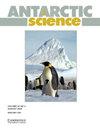Geochemistry of lake sediments from the South Shetland Islands and James Ross Archipelago, north Antarctic Peninsula
IF 2
4区 地球科学
Q3 ENVIRONMENTAL SCIENCES
引用次数: 0
Abstract
The geochemistry of lake sediments provides valuable information on environmental conditions and geochemical processes in polar regions. To characterize geochemical composition and to analyse weathering and provenance, 26 lakes located in six islands of the South Shetland Islands (SSI) and James Ross Archipelago (JRA) were analysed. Regarding major composition, the studied lake sediments correspond to ferruginous mudstones and to a lesser extent to mudstones. The weathering indices indicate incipient chemical alteration (Chemical Index of Alteration = 52.6; Plagioclase Index of Alteration = 57.6). The La-Th-Sc plot shows different provenance signatures. SSI lake sediments correspond to oceanic island arcs, whereas those of JRA denote a signal of continental arcs with mixed sources. In James Ross Island lake sediments are of continental arcs (inland lakes), oceanic island arcs (coastal lakes) and a middle signature (foreland lakes). Multi-elemental analysis indicates that the sediments are enriched from regional basalts in Ba, Rb, Th, Cs and U (typical of silica-rich rocks) and depleted in Cr and Co due to mafic mineral weathering. The geochemical signals identified by principal component analysis enable us to group the sediments according to the studied islands and their geomorphological characteristics. This study underlines the importance of knowing the geochemical background levels in pristine lake sediments to evaluate potential future anthropogenic effects.南极半岛北部南设得兰群岛和詹姆斯罗斯群岛湖泊沉积物的地球化学特征
湖泊沉积物的地球化学提供了极地地区环境条件和地球化学过程的宝贵信息。为了确定地球化学组成的特征,并分析风化和产地,对位于南设得兰群岛(SSI)和詹姆斯-罗斯群岛(JRA)六个岛屿上的 26 个湖泊进行了分析。就主要成分而言,所研究的湖泊沉积物属于铁质泥岩,其次为泥岩。风化指数显示了初步的化学蚀变(化学蚀变指数 = 52.6;斜长石蚀变指数 = 57.6)。La-Th-Sc 图显示了不同的来源特征。SSI 的湖泊沉积物与大洋岛弧相对应,而 JRA 的湖泊沉积物则显示了混合来源的大陆弧信号。詹姆斯-罗斯岛的湖泊沉积物有大陆弧(内陆湖)、大洋岛弧(沿岸湖)和中间特征(前陆湖)。多元素分析表明,沉积物富含来自区域玄武岩的 Ba、Rb、Th、Cs 和 U(典型的富硅质岩石),而由于岩浆岩矿物风化,富含 Cr 和 Co。通过主成分分析确定的地球化学信号使我们能够根据所研究的岛屿及其地貌特征对沉积物进行分组。这项研究强调了了解原始湖泊沉积物中地球化学背景水平对评估未来潜在人为影响的重要性。
本文章由计算机程序翻译,如有差异,请以英文原文为准。
求助全文
约1分钟内获得全文
求助全文
来源期刊

Antarctic Science
地学-地球科学综合
CiteScore
3.60
自引率
6.20%
发文量
42
审稿时长
3 months
期刊介绍:
Antarctic Science provides a truly international forum for the broad spread of studies that increasingly characterise scientific research in the Antarctic. Whilst emphasising interdisciplinary work, the journal publishes papers from environmental management to biodiversity, from volcanoes to icebergs, and from oceanography to the upper atmosphere. No other journal covers such a wide range of Antarctic scientific studies. The journal attracts papers from all countries currently undertaking Antarctic research. It publishes both review and data papers with no limits on length, two-page short notes on technical developments and recent discoveries, and book reviews. These, together with an editorial discussing broader aspects of science, provide a rich and varied mixture of items to interest researchers in all areas of science. There are no page charges, or charges for colour, to authors publishing in the Journal. One issue each year is normally devoted to a specific theme or papers from a major meeting.
 求助内容:
求助内容: 应助结果提醒方式:
应助结果提醒方式:


